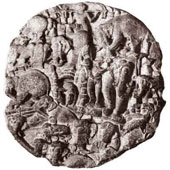SVNs are composed of certain finite elements. These elements are: Moment, Actor, Time, Space, Location / Place, Setting, Limits & Boundaries, Principles of Ordering and Relationship to text.
1. Moment: Refers to a slice of visual moment from the story represented.
2. Actor: Refers to the character in the story.
3. Time (Narrative time): Refers to the temporal aspect represented.
4. Space (Compositional Space): Refers to the surface area used to represent the visual.
5. Location or Place: Refers to the site where the event unfolds in the story.
6. Setting: Refers to the representation of the location or place where the event unfolds.
7. Limits and Boundaries: Refers to the demarcation technique of story space.
8. Principles of Ordering: Refers to the rational of arranging the story.
9. Relationship to Text3: Refers to the manner in which the texts (oral or written) relate.
Each of these is explained below using the example of the SVN – Adam and Eve.

Adam und Eva in Garten Eden - Lucas Cranach;
[Image source]
1) Moment:
Six events from the story are presented as six visual moments (M) in this SVN -
Event 1: God creates Adam – M1
Event 2: God creates Eve from Adam – M2
Event 3: God instructs Adam and Eve about the “tree of life” – M3
Event 4: The devil tempts Eve and she in turn temps Adam to eat the apple from the “tree of life” – M4
Event 5: God admonishes Adam and Eve as they attempt to hide – M5
Event 6: Adam and Eve are driven out of the Garden of Eden by an angel – M6
These are marked as M1, M2, M3, M4, M5 and M6 respectively.

2) Actor:
The actors in this SVN are Eve, Adam, God, the Devil in the form of a serpent and the angel. These are marked – A in the image. We identify the actors from the description we know of each of the characters.

3) Narrative time:
The narrative time in an SVN is indicated by the compositional space. The repetition of the actors indicates a movement in time from one event to the other. The narrative time in this SVN is traced by the dotted line. The direction of the movement of narrative story time is marked by the arrow. In this case the visual narrative flows broadly from right to left.

4) Compositional Space:
It is the surface occupied by the visual narrative on the medium. In this case the total visual composition occupies a rectangular area.

5) Location or Place:
The location is mentioned in most stories. This is the location where the event occurs. Some designers try to indicate the location of the event with the help of a setting as in this case. Sometimes the location is not indicated and left for the viewer to imagine. In this SVN the story unfolds at the Garden of Eden.

6) Setting:
Also referred to as background. The setting is created by the designer to help the viewer imagine the location where the event unfolds. It presents the designers imagination of the location. In this example the designer imagines the Garden of Eden as a garden with lots of flora and fauna.

7) Limits & Boundaries:
The frame is the device that demarcates the visual story space. In this example the SVN is enclosed by a rectangular frame.

8) Principles of Ordering:
The designer uses some philosophy to arrange the events of the story onto the surface of the medium. This guiding philosophy that governs the composition of the SVN is what we call as ‘principles of ordering’. In this particular instance the designer possibly decided to order the events according to the place in the garden where he thought they might have occurred. Thus the setting is used primarily as the guiding principle for ordering the events.
Another possible principle of ordering could be – the ordering of events. As seen in this SVN, event 3(marked as E3) is not only centered but also rendered larger compared to the other events. Based on this feature we can surmise that the designer wanted to draw attention to this particular event. Thus it may have been thought to be the most important event given that it contains the warning.
Yet a third possible principle of ordering could be deduced from the arrangement of the events, one that is timeline based.
The centered and enlarged event can be read as happing “now” in the present (as we watch) compared to events past and future.

9) Relationship to Text:
Three ways of interaction have been identified by Maria Nikolajeva and Carole Scott in their study of picture book communication, to which we concur. These are: Symmetric interaction: the image depicts exactly what the story says; Enhancing interaction: the image depicts more than what the story says; Complementary interaction: the images shows something totally different to what the story says.
Mc Cloud in ‘Understanding Comics’ also illustrates ways in which the text and visual interact.


